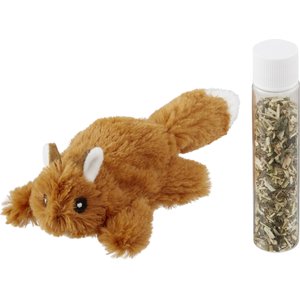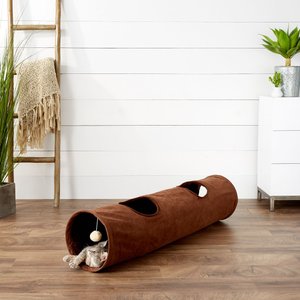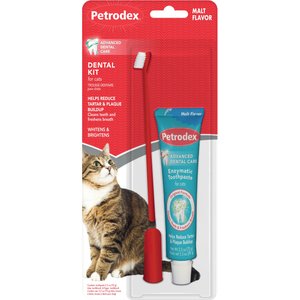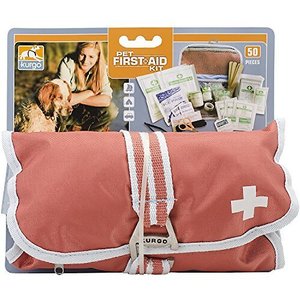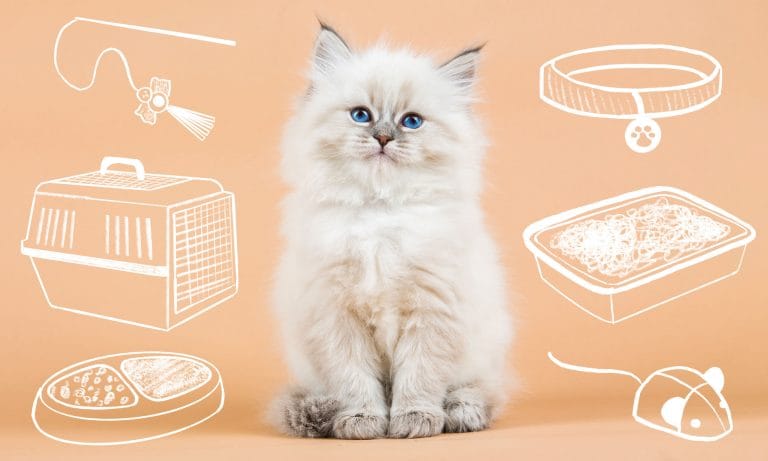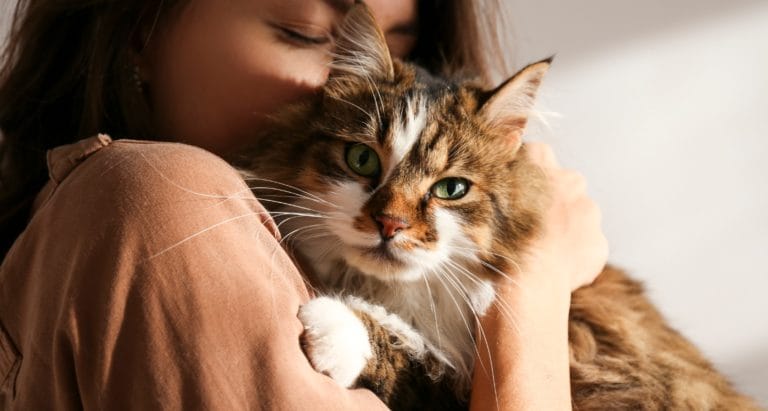Have you just adopted a cat? Congratulations! Even if this isn’t your first feline friend, adding a new cat to your family certainly is an exciting time—but wait! Is your home ready for a new pet? You’re going to need several cat essentials to get the place in shape to welcome your kitty.
Refer to our cat adoption checklist, full of tips for new cat parents, to ensure you have everything you need to start pet parenthood off on the right paw.
In This Guide:
Cat Adoption Checklist: Essential Cat Supplies
There are some cat essentials that all adoptive pet parents need to ensure their new furry family member feels safe and comfortable in their forever home. Go through this cat adoption checklist right meow so you’re prepared for their arrival with all the cat essentials you’ll need.
Food Necessities
- Dry and/or wet cat food
- Cat treats
- Food bowl and water bowl or fountain
Your cat’s foster family or rescue organization might indicate the type of cat food they’ve been feeding your new pet. If so, stock up on the specific formula that your cat is used to. (You can always slowly transition to another cat food later if approved by your vet.) Otherwise, purchase dry and/or wet cat food that meets the nutritional needs of your kitty, taking into consideration their age and any special medical needs. Try Tiny Tiger pate canned cat food or American Journey dry cat food, both formulated for adult cats. Consult your vet when choosing a cat food for your new pet.
Don’t forget to also pick up plenty of treats, like Blue Buffalo Wilderness cat treats, to welcome your new friend.
Of course, your kitty will also need food and water bowls. A water fountain, like the Cat Mate Pet Fountain, is a great option to encourage your cat to drink more water, as are automatic feeders, like PetSafe Eatwell 5-Meal Automatic Pet Feeder, that you can preload with just the right amount of food to prevent overfeeding.
Bathroom Basics
- Litter box or pan
- Scooper
- Litter
- Litter mat
Your kitty needs a special spot to do their business. You might want to consider a hooded or top-entry litter box, like the Frisco Top Entry Cat Litter Box, to keep scattered litter to a minimum. Understand, though, that not all cats take to enclosed litter boxes, and might need an open-air litter pan, like the Van Ness High Sides Cat Litter Pan, in order to feel comfortable doing their business.
Feline behaviorist Rita Reimers, founding president and owner of Just For Cats Pet Sitting in Charlotte, North Carolina, and Beverly Hills, California, says that if you have another cat in the house already, don’t expect them to share a single litter box. “It is best to have one box per cat, plus one extra box,” Reimers says. And if you live in a multi-level home, a box should be provided on each floor, she adds.
Litter is also a must-have. Choose a clumping formula for easy scooping, like Arm & Hammer’s Clump & Seal Multi-Cat Litter.
Speaking of scooping, don’t forget a scooper! The Litter Genie Plus Cat Litter Disposal System includes a scooper and a pail, which provides a way to lock away the waste from your daily litter box scooping sessions.
A litter mat, like the iPrimio Cat Litter Trapper EZ Clean Mat, is also useful in keeping scattered litter contained and not strewn all over your floor.
Cat Furniture
- Scratcher or scratching post
- Cat tree
- Cat bed
Give your cat an appropriate place to exercise their need to scratch. “Scratchers are essential for good paw and nail health—and for the safety of your furniture!” Reimers says. Try SmartCat’s The Ultimate Scratching Post. (Your carpet and curtains will thank you!)
You’ll want to consider procuring a cat tree, as well. “Cat trees are an excellent way to provide more space for your cats in smaller homes and apartments where horizontal space is limited,” says Reimers, who notes that they can also help your feline feel more secure.
“The majority of cats prefer to observe the world from up high, where they feel safe and untouchable,” Reimers says. “This is especially true of cats when they are in a new environment, as they feel more secure when they are up off the ground.”
Look for a tall and sturdy cat tree that’s ripe for exploring, like the Frisco 42-Inch Faux Fur Cat Tree & Condo.
And while you may be perfectly content to have your cat cuddle up in your own bed, be sure to buy them their own, too. Consider a cave-like cat bed, such as the Best Friends by Sheri Meow Hut Covered Bed, that’ll give your cat a safe space to tuck themselves away.
Toys
- Wand toy
- Catnip toy
- Ball toy
- Interactive toy
Bond with your kitty and help them burn off excess energy with tons of playtime. Engage their hunter instincts with a wand toy, like the Frisco Bird Teaser with Feathers Cat Toy or the Cat Dancer Original Cat Toy. “I haven’t met a cat yet that doesn’t love it,” Reimers says of the Cat Dancer.
Reimers’ own kitties are also fans of ball toys. “I often find myself playing fetch with them!” she says. Try the SmartyKat Flutter Balls Feathery Cat Toy.
And you’d be remiss to overlook the allure of catnip toys: “Anything filled with catnip is sure to be a hit,” Reimers says. Give them the taste of the good stuff with the Frisco Refillable Brown Squirrel Catnip Cat Toy.
You can also keep cats active even when you’re not home with interactive and electronic cat toys, like the Frisco Scratch & Roll Scratcher.
Grooming Supplies
- Deshedding brush
- Pet bath wipes
- Cat nail clippers
Keep your cat’s coat in tip-top shape with a deshedding tool, like the Safari Self-Cleaning Slicker Brush for Cats.
Have pet bath wipes on hand, too, to easily clean soiled fur. Try the Frisco Hypoallergenic Waterless Grooming Wipes, which are formulated to naturally moisturize paws and skin and keep the coat shiny and healthy.
Another necessity? A pair of cat nail clippers to keep your cat’s nails trimmed. The Pet Republique Cat Nail Clipper features an ergonomic design to make trims easy for you and your cat.
Travel Items
- Cat crate or carrier
- Cat collar
- Personalized ID tag
A cat crate or carrier is a must-have for taking your new cat home from the shelter or their foster family, and it will also come in handy for future trips to vet. The Catit Cabrio Multi-Functional Cat Carrier features removable food and water dishes to keep your kitty as comfortable as possible during transit.
It’s also a good idea to outfit your feline in a cat collar, like the Frisco Solid Nylon Breakaway Cat Collar (complete with a GoTags Personalized Stainless Steel ID tag, of course), in case they ever manage to escape from your home or their carrier.
Kitten Essentials
Many kitten essentials are similar to the supplies needed for an adult cat. However, you’ll want to ensure that all food, toys, bedding and healthcare supplies are suited to kittens in nutritional value, size and dosage.
Kitten essentials include:
- Kitten food
- Kitten toys
- Kitten-formulated, veterinary-recommended medications and supplements
- Kitten dental care
- Stain and odor remover spray
Feed kittens a diet formulated especially for them. “Look for food that is labeled specifically for growth and lactation,” says Dr. Sarah Wooten, DVM, from Sheep Draw Veterinary Hospital in Greeley, Colorado This type of food is typically higher in calories and is nutrient-dense. She suggests checking for the AAFCO statement on the food’s label. The AAFCO, or the Association of American Feed Control Officials, sets forth guidelines to ensure pet food meets nutritional standards. Consider formulas like Wellness CORE Grain-Free Kitten Formula Dry Cat Food to ensure that your kitten’s nutritional needs are being met.
Kittens can be especially active (when they’re not napping, that is!), so keep them engaged with toys like the Frisco Foldable Crinkle Play Tunnel and the KONG Kickeroo Kitten Toy.
Ensure with your vet that all medications and treatments are also appropriate for your cat’s young age. “The most important treatment for healthy kittens is preventing parasites and infectious disease,” Dr. Wooten says. “You should talk about deworming for intestinal parasites, flea and tick control and, depending on your geographical area and risk, heartworm prevention.” Look to kitten-specific treatments, such as the Advantage II Flea Treatment for Kittens, and be sure to talk to your kitten’s veterinarian before starting any medication or treatment.
This is also the time to get your kitty used to getting their teeth brushed, so you can provide proper dental care throughout their life. Choose a tiny toothbrush, like the Woobamboo Small Dog and Cat Toothbrush, that’s a perfect fit for your kitten’s small mouth.
You might also want to stock up on an extra bottle of two of the Nature’s Miracle Just for Cats Stain & Odor Remover Spray, or a similar stain and odor remover, in case your kitten hasn’t quite mastered the litter box yet.
Learn more about kitten essentials.
Welcoming Home Your New Cat
Give your kitty the warmest of welcomes by following these tips to ensure a smooth transition when introducing a new cat to your home.
Cat-Proof Your House
Remember that cats and especially kittens are curious: Keep breakables and dangerous items, like cords and wires, safely tucked away.
Reimers suggests getting down to a cat’s level to see the world from your new pet’s vantage point, clearing the floor of anything that they could easily chew and/or swallow. Next, pay attention to what reaches their tail level. “Are there breakables that might be sent to the floor with a flick of the tail?” Reimers asks.
Ensure that all window screens are secure and that toilet seats are always left down (so no one ends up taking an accidental swim!), instructs Reimers. Finally, refer to this list of poisonous plants, and check that all the greenery in your home is nontoxic to cats.
Create a Cats-Only Space
When introducing a new cat to your home, keep them confined to a single room for the first few days. Your new family member can easily become overwhelmed by the unfamiliar environment, so shrinking their space to just one room can help them feel safe.
Choose a room that’s located in a quieter part of your house or apartment, and keep their litter box, bed, food and water there until after the confinement period. “Spend lots of one-on-one time with your cat, and when you feel they be might be open to exploring, just leave the door to the room open,” Reimers says. “They’ll come out when they’re ready. Never force the situation—let your cat set the pace.”
Make Introductions
If you have other pets in the home, it’s important to properly introduce all your fur friends.
“Patience is the big key here, as you’re likely to have the resident pet(s) feeling somewhat jealous and insecure, and the newbie feeling insecure,” Reimers says.
“Mutual play time, feeding times and grooming times will help them all to anticipate good things will happen in one another’s company,” she adds, “and soon all the anxiety will disappear.”
Learn more about how to properly introduce a new cat to a resident feline.
Be Tolerant of Timidity
Welcoming a new cat into your home doesn’t always mean immediate cuddles and playtime. Changes in their environment can cause a cat to act shy and timid, hiding under your bed or refusing to explore their new home outside of the room you originally set them up them in. If this is the case, don’t force them to interact. “Spend some time sitting by their hiding place,” Reimers says. “Talk to them or read out loud in a soothing voice.”
Offer high-value cat treats to calm and entice them, or try wand-type toys that allow cats to interact at a distance, suggests Reimers. “Once your cat starts feeling more secure, they’ll come over to you,” she says.
Remember that some cats are just naturally less extroverted than others. Be patient and try to keep their new environment as stress-free as possible.
Learn more about how to accommodate a shy cat.
Identify a Veterinarian
Even if your new cat isn’t due for an exam just yet, it’s important that you seek out a veterinarian immediately in case of emergencies and for wellness check-ups in the future.
When the time for your cat’s first veterinary exam does arrive, there are a few things you can typically expect, according to Dr. Wooten. First, the veterinary team will collect any information you have on your cat, such as their approximate age, whether they’ve been spayed or neutered, previous diseases they may have had, and any vaccines, preventive care or medications they’ve been given. Be sure to get as much of this medical information that you can from your cat’s shelter or rescue organization.
After you pass along all the information you have, the actual exam will begin. “The veterinary technician will weigh your cat and take vitals,” Dr. Wooten says. “The veterinarian will conduct a full physical exam, and then make recommendations for your cat's health.”
Post-Adoption Healthcare Checklist for Your New Cat
Now that you have all the cat essentials covered, don’t forget about these all-too-important healthcare to-dos to ensure that your cat’s first year in their new home is a happy and healthy one.
- Cat vaccinations
- Flea and tick prevention
- Heartworm prevention
- Dental care
- Veterinary-recommended vitamins and supplements
- Microchip
- Pet first aid kit
Cat Vaccinations
Cat vaccinations will be an essential part of your new pet’s healthcare needs. “Kitten vaccines are done in series, which means that your kitten will receive vaccines every couple of weeks until about 16 weeks of age,” Dr. Wooten says.
All cats need to be up-to-date on their core vaccines to prevent disease. “Core vaccines include rabies and distemper vaccines,” Dr. Wooten says. There are also “lifestyle vaccines,” which are not always required. Aptly named, their necessity is based more on your and your cat’s lifestyle. For example, “Feline leukemia is a lifestyle vaccine that is based upon your kitten's risk factors, which you will discuss and decide with your veterinarian,” says Dr. Wooten. Risk factors could potentially include mutual grooming with other cats and outdoor access.
Your cat’s rescue organization will likely provide you with their medical history, outlining what vaccinations they have received and when. Refer to this when discussing with your veterinarian which vaccinations they recommend for your cat.
Learn more about cat vaccinations.
Flea and Tick Prevention
Flea and tick prevention and (sometimes, unfortunately) treatment should also be discussed with your veterinarian. “Flea and tick control is as important in cats as it is in dogs,” Dr. Wooten says. “Flea and tick control not only keeps pests off your cat, but it also protects your cat against diseases transmitted by fleas and ticks, such as tapeworms.”
Your vet may recommend a flea and tick preventive for your cat, like Bravecto Topical Solution, to thwart pests. No matter what you end up using, be sure it is specifically formulated for cats.
“Flea and tick products that are licensed for use only in dogs and over-the-counter flea products that contain synthetic pyrethroids should not be used on cats because they are toxic,” Dr. Wooten says. “Flea and tick products prescribed by veterinarians are usually the safest and most effective products available.”
Learn more about flea and tick prevention and treatment for cats.
Heartworm Prevention
“Heartworm disease is underreported and underdiagnosed in cats because we don't routinely test for it,” Dr. Wooten says. “However, cats are as susceptible to heartworms as dogs are, and they are more sensitive to heartworms because their hearts are so small.”
Ask your cat’s rescue organization if they have tested your cat for heartworms. If your cat hasn’t been tested, you can request that they be tested during your first veterinary visit. “The test for heartworms is a simple blood test,” Dr. Wooten says.
Depending on the results, discuss heartworm prevention or treatment options with your vet. They may recommend a heartworm preventive, like Revolution Topical Solution. “Heartworm products should be licensed for use in cats, and should contain selamectin or ivermectin,” Dr. Wooten says.
Dental Care
Proper dental care is an important factor in keeping certain diseases, such as periodontal disease, at bay. Pick up a toothbrush and toothpaste specifically designed for pets, like the Sentry Petrodex Veterinary Strength Malt Toothpaste Dental Care Kit for Cats, and start to work regular teeth brushings into your cat’s routine. (The task isn’t as daunting as it sounds!)
Learn how to brush your cat’s teeth.
Vitamins and Supplements
Depending on your cat’s specific needs, consider adding additional vitamins and supplements to their diet. Senior cats, for instance, might benefit from joint health supplements, like Nutramax Cosequin Capsules Joint Health Cat Supplement, or a fish oil supplement, like Zesty Paws Wild Alaskan Salmon Oil Liquid Skin & Coat Supplement for Dogs & Cats. “Dry, flaky coats, allergies, arthritis and kidney disease can benefit from fish oil or other sources of omega fatty acids,” says Jess Trimble, DVM, head of health for Fuzzy Pet Health in San Francisco, California.
Consult your vet before beginning any and all vitamins and supplements.
Learn more about cat supplements.
Microchip
Your cat may have been microchipped by their rescue organization. If so, ask the organization how to update the microchip with your contact information.
If your cat isn’t yet microchipped, have one implanted ASAP. Like the personalized ID tag on the cat supplies checklist above, it’ll help get your new pet back where they belong if they ever become lost.
Learn more about pet microchips.
Prep for Emergencies
You’ll, of course, do anything to keep your new cat safe, but, sometimes, accidents happen. Prepare for these emergencies with a pet first aid kit that’s stocked with medical essentials like tweezers and gauze pads.
The Kurgo Pet First Aid Kit has tools to help you handle an emergency until you’re able to get to your vet or a 24-hour pet hospital.
Training
While you may not be training your kitty to sit and fetch (although cats are trainable!), your new best friend might still need some help learning the ropes.
Litter Box Training
“Most cats are taught as small kittens by their mothers to use their litter box,” Reimers says. However, if you notice your cat having accidents around your home, first ensure that the litter box is being kept clean, and is located in a low-traffic area that is separate from your cat’s sleeping and eating areas. “Keep it away from their food and water,” Reimers says.
If your kitty’s litter box is covered, try removing the hood. The enclosed space might make them feel vulnerable, preventing them from wanting to climb in and do their business.
Your kitten may need further instruction. If you see your kitten going potty outside their litter box, “Quietly pick them up and place them inside the box, and they will understand after a few times,” Reimers says. “Using litter [attractant], such as Dr. Elsey's Precious Cat Attract Unscented Clumping Clay Cat Litter or Dr. Elsey's Kitten Attract Clumping Clay Cat Litter, may help them to learn even quicker.” It contains a natural herbal attractant to encourage litter box use.
There might also be a medical issue, such as a urinary tract infection, at play that is preventing a cat or kitten from using their litter box. Contact your veterinarian to explore any possible medical reasons behind your cat’s litter box troubles.
Learn more about litter box training.
Scratching Prevention Training
“It’s natural instinct for cats to scratch,” Reimers says. “It removes the dead outer sheathes of their claws, and also allows cats to stretch out their paws and toes. Cats also use the glands on their paws for scent marking, as well.”
But if your furniture, carpet or curtains are bearing the brunt of your cat’s scratching instincts, offer them scratchers or scratching posts as enticing alternatives. “Spray these items with catnip spray or [sprinkle] with loose catnip to encourage your cat to use them,” Reimers says. Try OurPets Cosmic Catnip to make your cat’s new scratcher even more attractive to your kitty.
“Covering your furniture with unpleasant sensations, such as double-sided sticky tape or plastic couch protectors and scratch guards, will also help discourage your cat from scratching them,” Reimers says. Try Sticky Paws on a Roll. It’s designed to protect your furniture from your kitty’s claws, forcing them to move on to the proper scratching outlets you’ve provided.
Learn more about training your cat to not scratch furniture.
Share:











